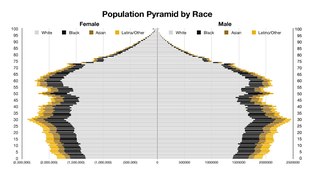
African Americans are an ethnic group consisting of Americans with partial or total ancestry from sub-Saharan Africa. The term "African American" generally denotes descendants of enslaved Africans who are from the United States. While some Black immigrants or their children may also come to identify as African-American, the majority of first generation immigrants do not, preferring to identify with their nation of origin.

Lafayette Parish is a parish located in the U.S. state of Louisiana. According to the 2020 U.S. census, the parish had a population of 241,753, up from 221,578 at the 2010 United States census. The parish seat is the city of Lafayette. The parish was founded in 1823. Since 1992, Lafayette City and Lafayette Parish have operated as a consolidated government.
Multiracial people are people of more than one race or ethnicity. A variety of terms have been used both historically and presently for multiracial people in a variety of contexts, including mixed-race, biracial, multiethnic, polyethnic, occasionally bi-ethnic, Métis, Creole, Muwallad, Colored, Dougla, half-caste, ʻafakasi, mestizo, Melungeon, quadroon, octoroon, sambo/zambo, Eurasian, hapa, hāfu, Garifuna, pardo and Guran. A number of these terms are now considered offensive, in addition to those that were initially coined for pejorative use.
The following are links to lists of United States cities in which a majority of the population is not white organized by majority racial group. The US census officially recognizes six racial categories: White American, Black or African American, Native American and Alaska Native, Asian American, Native Hawaiian and Other Pacific Islander, and people of two or more races. It should not, however, be inferred that every city not on one of the lists below has a white majority.
Latin Americans are the citizens of Latin American countries. Latin American countries and their diasporas are multi-ethnic and multi-racial. Latin Americans are a pan-ethnicity consisting of people of different ethnic and national backgrounds. As a result, some Latin Americans do not take their nationality as an ethnicity, but identify themselves with a combination of their nationality, ethnicity and their ancestral origins. Aside from the Indigenous Amerindian population, all Latin Americans have some Old World ancestors who arrived since 1492. Latin America has the largest diasporas of Spaniards, Portuguese, Africans, Italians, Lebanese and Japanese in the world. The region also has large German, French, Palestinian, Chinese and Jewish diasporas.
The following are links to lists of United States cities with large ethnic minority populations.
White Americans are Americans who identify as and are perceived to be white people. This group constitutes the majority of the people in the United States. As of the 2020 Census, 61.6%, or 204,277,273 people, were white alone. This represented a national white demographic decline from a 72.4% share of the US's population in 2010.

The United States of America has a racially and ethnically diverse population. At the federal level, race and ethnicity have been categorized separately. The most recent United States Census officially recognized five racial categories as well as people of two or more races. The Census Bureau also classified respondents as "Hispanic or Latino" or "Not Hispanic or Latino", identifying Hispanic and Latino as an ethnicity, which comprises the largest minority group in the nation. The Census also asked an "Ancestry Question," which covers the broader notion of ethnicity, in the 2000 Census long form and the 2010 American Community Survey; the question worded differently on "origins" will return in the 2020 Census.

Caribbean Americans or West Indian Americans are Americans who trace their ancestry to the Caribbean. Caribbean Americans are a multi-ethnic and multi-racial group that trace their ancestry further in time mostly to Africa, as well as Asia, the Indigenous peoples of the Americas, and to Europe. As of 2016, about 13 million — about 4% of the total U.S. population — have Caribbean ancestry.
Black Hispanic and Latino Americans, also called Afro-Hispanics, Afro-Latinos or Black Hispanics, or Black Latinos are classified by the United States Census Bureau, Office of Management and Budget, and other U.S. government agencies as Black people living in the United States with ancestry in Spain or Latin America and/or who speak Spanish, and/or Portuguese as their first language.
South African Americans are Americans who have full or partial ancestry from South Africa. As of 2012, there were approximately 80,000 people born in South Africa who were living in the United States. As of 2019, there were approximately 85,000 people born in South Africa who were living in the United States.

Americans are the citizens and nationals of the United States of America. Although direct citizens and nationals make up the majority of Americans, many dual citizens, expatriates, and permanent residents could also legally claim American nationality. The United States is home to people of many racial and ethnic origins; consequently, American culture and law do not equate nationality with race or ethnicity, but with citizenship and an oath of permanent allegiance.
African American Texans or Black Texans are residents of the state of Texas who are of African ancestry. African Americans formed a unique ethnic identity in Texas while facing the problems of societal and institutional discrimination as well as colorism for many years. The first person of African heritage to arrive in Texas was Estevanico, who came to Texas in 1528.

Adherents of Islam constitute the world's second largest religious group. According to a estimation in 2020, Islam has 1.9 billion adherents, making up about 24.7% of the world population. Most Muslims are either of two denominations: Sunni or Shia. Islam is the majority religion in several subregions: Central Asia, West Asia, North Africa, the Sahel, and the Middle East. The diverse Asia-Pacific region contains the highest number of Muslims in the world, easily surpassing the combined Middle East and North Africa.